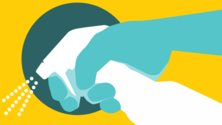
-adapted from NY Department of Health Interim Cleaning and Disinfection Guidance for Primary and Secondary Schools
Soiled and frequently touched areas can be reservoirs for pathogens that cause illness in people, therefore routine cleaning should continue as part of standard infection-control protocols in schools. Cleaning removes germs, dirt, and impurities from surfaces or objects, while disinfecting kills germs on surfaces or objects.
Before a confirmed case of COVID-19 occurs in the schools, specific high-risk locations within a school warrant cleaning and disinfection:
Health Office: Clean and disinfect health cots regularly (after each student use). Cover treatment tables and use pillow protectors. Discard or launder coverings after each use Lunchrooms. Clean and disinfect lunch tables regularly (at least once daily).
Athletic Rooms: Establish a regular cleaning schedule for shared environmental surfaces such as wrestling mats or strength-training equipment. Disinfect mats and other high-use equipment at least daily.
Other Frequently Touched Surfaces: Clean and disinfect frequently touched surfaces at least once daily after students have left for the day.
After a laboratory confirmed case of COVID-19 was symptomatic while in the school setting occurs:
Custodial staff should perform cleaning and disinfection of frequently touched areas throughout the school.
Step 1: Cleaning: Always clean surfaces prior to use of disinfectants in order to reduce soil and remove germs. Dirt and other materials on surfaces can reduce the effectiveness of disinfectants. For combination products that can both clean and disinfect, always follow the instructions on the specific product label to ensure effective use.
Step 2: Disinfection: Cleaning of soiled areas must be completed prior to disinfection to ensure the effectiveness of the disinfectant product. Disinfect bathrooms, food preparation surfaces and frequently touched surfaces using a disinfectant labeled to be effective against human coronavirus (see list of EPA registered products here), if available, or use a freshly mixed chlorine bleach solution (approximately 1 tablespoon of bleach in 1 quart of water) if an approved disinfectant is not available.
Examples of frequently touched areas in schools: Classroom desks and chairs; Lunchroom tables and chairs; Door handles and push plates; Handrails; Kitchen and bathroom faucets; Light switches; Handles on equipment (e.g., athletic equipment); Buttons on vending machines and elevators; Shared telephones; Shared desktops; Shared computer keyboards and mice; Bus seats and handrails.
Note: Computer keyboards are difficult to clean due to the spaces between keys and the sensitivity of its hardware to liquids. When shared, they may contribute to indirect transmission. Locations with community use computers should provide posted signs regarding proper hand hygiene before and after using the computers to minimize disease transmission. Also, consider using keyboard covers to protect the hardware against spills and facilitate cleaning.
Label directions must be followed when using disinfectants to ensure the target viruses are effectively killed. This includes adequate contact times (i.e., the amount of time a disinfectant should remain on surfaces to be effective), which may vary between five and ten minutes after application. Disinfectants that come in a wipe form will also list effective contact times on their label.
For disinfectants that come in concentrated forms (including bleach), staff should carefully follow instructions for making the diluted concentration needed to effectively kill the target virus. This information can be found on the product label. Disinfecting is the responsibility of school custodial staff. They are trained to use disinfectants in a safe and effective manner. Staff are reminded to ensure procedures for safe and effective use of all products are followed. Staff do not need to wear respiratory protection (e.g., masks) while cleaning. Safety instructions are listed on product labels and include the personal protective equipment (e.g., gloves) that should be used. Place all used gloves in a bag that can be tied closed before disposing of them with other waste. Wash hands with soap and water for at least 20 seconds immediately after removing gloves or use an alcohol-based hand-sanitizer if soap and water are not available. Soap and water should be used if hands are visibly soiled.
|